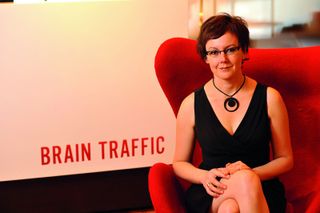Kristina Halvorson on content strategy
As more and more content is unleashed onto the web, organisations are crying out for a way to manage it all. Tom May chats to Kristina Halvorson about the emerging discipline of content strategy and how to make it work for you
This article first appeared in issue 219 of .net magazine - the world's best-selling magazine for web designers and developers.
As recently as 2009, the term “content strategy” was one that was rarely heard and little understood. Right now, it’s big news: there are books on content strategy, agencies specialising in content strategy, even content strategy conferences. And that’s in large part due to the relentless work and campaigning of one Kristina Halvorson.
Widely recognised as the leading advocate for this emerging discipline, Halvorson is the founder and CEO of content strategy consultancy Brain Traffic, author of the 2009 book Content Strategy for the Web; founder of Confab, the content strategy conference; and host of Content Talks, a weekly 5by5 podcast. So she’s the ideal person to answer the question still on many people’s lips ... what exactly is content strategy?

“Content strategy identifies how content will help achieve your business objectives,” Halvorson explains. “It informs how organisations create, deliver and govern or take care of their content, online and beyond. It helps people move from thinking about content ‘launch’ to content ‘life cycle’, allowing them to create a plan to manage that content over time.”
“Over time” is the key phrase here. Many people assume that content strategy is about content creation – but in fact, that’s the easy bit. It’s what Halvorson calls the “messy stuff” surrounding the long-term management of content that forms the real challenge. Essentially, she explains, it’s all about asking the right questions early on in the process – “Who is the content coming from? Who owns the content? How will that content be maintained and developed after launch?”
“So really it’s about working to move organisations’ focus away from launching content and towards looking at content as something that lives within a long-term life cycle. And that requires a longer commitment than just a copywriter and a project manager for the website launch.”
Changing attitudes
It’s only in the last couple of years that the industry has started to take content strategy seriously, says Halvorson. “Agencies have been trying to sell some form of content strategy for years, knowing that their clients need more than just a couple of copywriters – yet nobody’s ever wanted to pay for it. It’s only been recently they’ve even pitched content strategy, and now clients are actually coming to agencies and asking for it.” So why the change? “I think it’s simply because over the years their websites have become such a mess. There’s so much additional content that needs to be created, and once the content’s out there, it’s out there, and it’s not going away. They’re having to pile it up and keep tacking things on, but they recognise it’s not a long-term solution.”
It's the content that needs to be addressed rather than changing the visual design or making quick fixes to user experience
In other words, the idea that design should serve the content and not the other way round is finally gaining momentum. “People are realising that it is in fact the content that needs to be addressed rather than changing the visual design or making quick fixes to user experience.”
But if the theoretical argument is being won, what about on the ground? To what extent are mainstream companies actually implementing content strategy in practice? “I think that’s a more difficult question to answer because content strategy has only really got on people’s radars within the past 12-18 months,” Halvorson admits. “But what’s great is that the people who’ve been doing the work are now being elevated with regard to their roles in the company’s non-project teams and so on, to really start having more empowerment and more responsibility.
“That said, I don’t think that content strategy is something we can just look at the project level,” she continues. “Once we’re able to demonstrate its value there, it really is something that needs to be looked at from a company-wide level. Who’s going to be responsible for taking care of content? Who gets to say yes to new content? Are the right people in power? Do we have the right skillsets internally? We need to be asking these kinds of questions.”

As a side note, Halvorson adds that content strategy is not vital, or even appropriate, for every business. “Really small companies, you know, one to ten people, they really just need a smart copywriter who’s going to help ensure the copy is appropriate and structured well and keep the website at a manageable size,” she says. “Those folks don’t need a full-on content strategy. And frankly not every project is going to need content strategy.” But for those working in large organisations, or on sites with large amounts of content, content strategy is increasingly important. So how exactly do you go about it?
“There are a variety of responses to that question, largely based on what your role is and what you’re trying to accomplish,” Halvorson replies. “But here are some good places to start. Audit your content. Figure out what you have. Talk to the people you report up to. Find out what is keeping them up at night with regard to content and then come up with some pretty simple solutions as to how you can begin to attack little pieces of it. Plus you definitely need to find an internal sponsor – someone who knows that content is a problem – and work with them to get buy-in throughout the organisation.”
To learn more about the subject, Halvorson’s book is the obvious starting point; she also recommends Elements of Content Strategy by Erin Kissane. “Both books are very short and
complement each other, so they’re great places to begin,” she says. To further develop your skills and understanding, she suggests getting involved in a local content strategy meetup. “Go online to Meetup.org and see if there’s one in your area,” she recommends. “If there’s not, tweet it and @ me on it, and I’ll advertise it on Twitter, saying: ‘Who else wants to do that in that area?’”
Taking it further
What if you wanted to become a content strategy specialist yourself – would you need a background in user experience? Halvorson shakes her head. “Not at all. Certainly the conversation started within the UX community, but the conversation is now starting to take hold within other specialisms. Marketing communications, internal communications, online learning, corporate communications, PR ... Those folks are all starting to think: ‘Wow, I can’t just blast stuff out there and then walk away from it any more; this needs to be more of an integrated, long-term plan for the life cycle of this content.’
The conversation started within the UX community, but is now starting to take hold within other specialisms
“People involved in long-term CMS solutions are also starting to really embrace content strategy,” she adds. “Karen McGrane just spoke at DrupalCon in Chicago and was talking about why CMS implementations fail. And she told them it’s the content strategist and the content manager who are the most critical to the success of these launches, not the Drupal programmers. She said that to 500 Drupal folks – and they applauded!”.
Tales like this are testament to the progress of content strategy over the last few years. But it’s still early days. Next for Halvorson is a second, updated edition of her book, to be called Content Strategy for the Web (and Beyond), which she’ll co-author with Melissa Rach, VP of content strategy at Brain Traffic. “She and her team are responsible for the rapid evolution of our own practice, and I think it’s important she leads the development of the sections on methodology. I’ll be working on things like content strategy history, job descriptions, case studies, interviews, industry trends, and what companies need to be thinking about in the months and years to come.
“While the field has been around for 15 years, it’s evolving at the speed of light, which is tough because so many people are just now learning about it. We’re hoping to provide an updated, forward-looking approach that will still be as practical as it was in the first book.”

Thank you for reading 5 articles this month* Join now for unlimited access
Enjoy your first month for just £1 / $1 / €1
*Read 5 free articles per month without a subscription

Join now for unlimited access
Try first month for just £1 / $1 / €1
Get the Creative Bloq Newsletter
Daily design news, reviews, how-tos and more, as picked by the editors.
The Creative Bloq team is made up of a group of design fans, and has changed and evolved since Creative Bloq began back in 2012. The current website team consists of eight full-time members of staff: Editor Georgia Coggan, Deputy Editor Rosie Hilder, Ecommerce Editor Beren Neale, Senior News Editor Daniel Piper, Editor, Digital Art and 3D Ian Dean, Tech Reviews Editor Erlingur Einarsson, Ecommerce Writer Beth Nicholls and Staff Writer Natalie Fear, as well as a roster of freelancers from around the world. The ImagineFX magazine team also pitch in, ensuring that content from leading digital art publication ImagineFX is represented on Creative Bloq.
